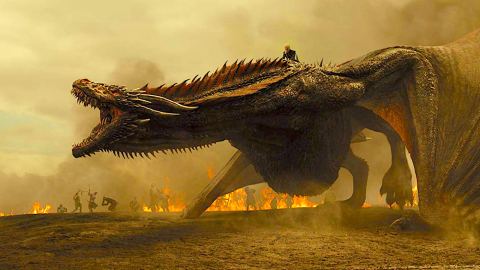When everyone watches dragons

(IMAGE: HBO)
On Sunday night, millions of people around the world waited impatiently for HBO to unlock the penultimate episode of Game of Thrones. It was an important event, but not for the reasons you might think.
(Note: Minor spoilers ahead for those who haven’t yet watched Season 8, Episode 5.)
Sure, there was a great battle between two powerful armies, each led by a powerful queen. Sure, there was a big dragon laying waste to a city while a host of characters that fans had been following for a decade met a host of ends. And sure, immediately after the final credits ran there were howls of online outrage from viewers who thought the show had lost its way or the cries of delight from those who were sure it hadn’t.
But that’s not the importance I’m talking about it. All that collective viewing and discussing of Game of Thrones was important because it was a reminder of how our technology shapes, and reshapes, the human experience of time.
Human beings are, fundamentally, social animals. That means there is another layer to our experience of time beyond what biology sets (as in circadian rhythms). Because we are also, fundamentally, tool-building animals, our technology has always been deployed in the service of organizing our activities in social settings. Thus, ever since we began organizing ourselves into villages, and then towns, and then cities, we have been using our technologies to organize time.
The most dramatic example of this was the invention of mechanical clocks and the regulation of time in medieval cities (the kind that got burned up in Sunday’s GoT episode). Before clocks, a complex array of bell-tolling was used to tell townspeople things like when to go to market, when the market closed, etc. When the first clocks appeared in Italian cities, they greatly simplified this system by just striking out the hours. Within a generation, people were living by clock time. This meant stopping for lunch not when you were hungry or when the sun was about “so high” in the sky, but when the clock deemed it time to do so.
In the modern era, this rule of time by machine became more pervasive. Most importantly, it came to rule culture via the development of radio and television networks. In the early 1920s, a few bold entrepreneurs began setting up radio “stations” where they would play records for anyone who had a radio. In just a few years, these stations multiplied like daisies until savvy investors realized that by linking the stations together into networks, they could deliver content simultaneously to the whole nation. By the 1930s, radio was the cultural lifeblood of the nation, binding it together through shared, simultaneous experiences like the famous 1938 Joe Louis vs. Max Schmeling boxing match.
TV takes it up a notch
With the advent of television, this “cultural now” became even more pervasive. The shows the networks hosted only appeared once a week at their scheduled times (with, of course, the additional time technology of time zones). This meant popular shows became events in themselves as people waited for the latest episode of I Love Lucy, Hill Street Blues or Cheers. That shared experience led to others, like the ritual unpacking of the episode the next day among friends. And for events like the Olympics, the audience for this shared “now” rose from national to global.
The important thing to see here is that what might seem like an innocent communication technology was really something far more powerful. By creating a shared sense of now across an entire planet, TV networks were really rewiring our sense of time—our sense of how it appears and how flows across space.
As I argued in my book About Time: Cosmology and Culture at the Twilight of the Big Bang, there has always been a powerful interchange between our scientific ideas about time and the way culture shapes time through our technologies.
Recently those shared experiences of cultural “now” moments have been denuded. The advent of streaming services like Netflix means that many of the shows we talk about are delivered all at once, instead of one episode at a time. We get the whole story. Then, as with novels, we each make our own way through the story in our own time—we could binge it all at once, or take our time for weeks on end. For popular shows like The Marvelous Mrs. Maisel or Stranger Things, we no longer have a single national moment of revelation. One moment there’s nothing; the next moment, an entire new season awaits us.
That’s why Game of Thrones has been different. It’s released in weekly installments. One. Episode. At. A. Time. That’s what makes GoT important. It’s a harkening back to a different era. A call back, literally, to a different time.
We can’t really argue for which kind of time is better. Each is the creation of the culture, using a particular form of time-shaping technology. But what we can do is see how these technologies lead to the unconscious shaping of time so that we might have a little more capacity to decide how it shapes us.
The post When Everyone Watches Dragons appeared first on ORBITER.





